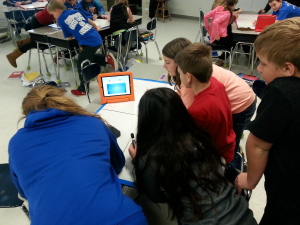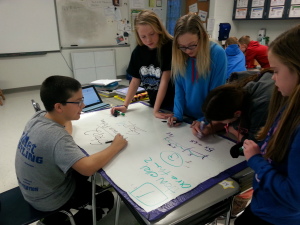Comfy Chaos in the Middle School Classroom
Amy Wix
MCTM District 1 Director, Teacher at Kasson-Mantorville Middle School
When you tell people you teach middle schoolers, do you get that look that says:
- You must be a saint/crazy/off your rocker.
- But you look so normal!
- I could never do what you do!
I’m familiar with these looks; they are the same ones I give to kindergarten teachers and first year band directors – who all rank up there with saints in my book! When I meet a middle school teacher, I think to myself, “Wow, someone who understands my world!”
Kim Campbell (NMSA consultant and Hopkins West Jr. High teacher) wrote an intriguing article “Get Your Students Moving” for AMLE Magazine last year. She quoted fellow AMLE presenter Mark McCleod as saying, “When the butt goes numb, the brain goes dumb.” Basically, students can handle actively listening 1 minute for every year of age. So, my 6th grade students have about 11-13 minutes before I need to get them moving. After reading the article, I was motivated to incorporate even more movement in my math classes. I’ll share a few of my favorites.
I love starting my classes with Estimation 180 from Andrew Stadel’s site www.estimation180.com along with the handout created by Michael Fenton The students in the back of the room quickly move to the front, thinking they miss out on something in the picture. After they make their estimates and explain their reasoning, we talk about it as a class. The best part is listening as they share their process and watching the “a-ha!” moments for the other students. After sharing their estimate with a peer, we reveal the answer and hear “oh, I was so close,” “I was 150% off!” or “I’m getting closer with my estimates!” Once the routine is set, it takes just a few minutes at the beginning of class. Students are thinking, students are talking and students are moving.
 I would be lost without my whiteboards. I have a variety of sizes – small 10” by 12” graphing board, 16” by 24” for individual work and 31”by 48” for group problem solving. When a new concept is introduced, the students practice on the white boards. When they have their work finished they hold them up and I can see immediately who is understanding and who needs some extra help. Added bonus – the students are moving. We are starting to incorporate BYOD in our classes. I will have the students snap a picture of their solution and submit it to a Nearpod session, which works great when we are doing group problem solving.
I would be lost without my whiteboards. I have a variety of sizes – small 10” by 12” graphing board, 16” by 24” for individual work and 31”by 48” for group problem solving. When a new concept is introduced, the students practice on the white boards. When they have their work finished they hold them up and I can see immediately who is understanding and who needs some extra help. Added bonus – the students are moving. We are starting to incorporate BYOD in our classes. I will have the students snap a picture of their solution and submit it to a Nearpod session, which works great when we are doing group problem solving.
A review strategy I like to use with my classes is a spin off from a Carousel. I create review questions (usually in google slides so I can print off sheets) and have at least one question per student. The students have an answer sheet they write on. Each student stands behind a desk with the question face down. When the timer starts they flip the paper over and answer the question. I generally allow 30-45 seconds per question, then they flip them back over and carousel around the room. Students have learned to copy down the problem to work on later if they think it will take them longer than the time limit. It’s quick, students are engaged and it’s great for practice or review.
The last activity I’ll share is the “Do you know What You are Asking?” activity. I like to do this early in the school year to collect information I can use all year long. I stick one question to each students back. All of the students have to walk around the room, recording the answers to their question on their sheet. Questions range from “What is your age?” to “How many stars are on the US flag?” to “Do you know what show Bert the Farting Hippo is in?” After collecting the answers, the students try and guess what their question was. We have a good discussion about categorical vs. numeric data. The thing I like best about this is that I have 27 or so sheets per class that I can pull out on those days when the lesson goes faster than planned or the days (like right before winter break) when you don’t want to start a new concept. We can use the information to practice mean, median, mode, stem-and-leaf plots, whisker graphs, etc.
Those of us who work with middle schoolers know this already – but just a reminder: when middle schoolers move they make noise – lots of it! You know you’ve had a good day when the students say “Class is over already? Why does this class go so fast?” Don’t get me wrong, I like nice quiet classrooms. However, when I want my students engaged in the lesson, they are moving about and they get loud. Just like the kindergarten teacher who ties shoes and zips coats as part of their day, and the band director who can actually hear improvement from day to day with the screech coming from the new saxophone player, we as middle school teachers need to embrace the chaos and make it comfortable- for both our students and ourselves.
How do you incorporate movement in your class? I’d love to hear your comments.
http://goo.gl/FNPuxL Link to Kim Cambell’s AMLE article
http://goo.gl/157NSh Link to Michael Fenten’s Estimation 180 handout
http://goo.gl/S7NgYl Link to Do You Know What You Are Asking?


